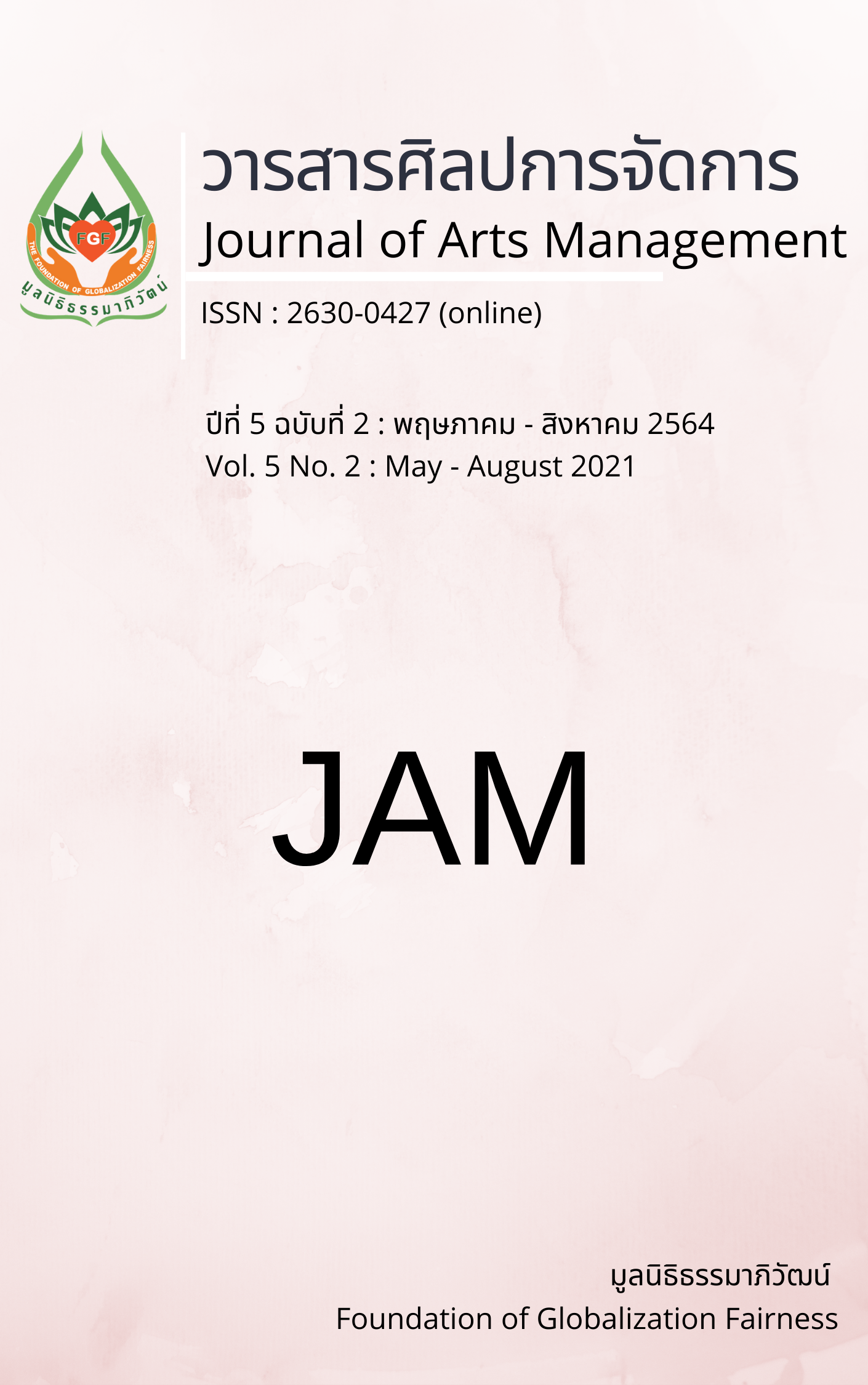The Influence of Causal Factors on Purchasing Intention Souvenir Product of Korean Idol Group BTS on Twitter of Consumers in Bangkok and Its Vicinity
Main Article Content
Abstract
This research aimed to (1) develop and validate the consistency a causal of relationship model of purchasing an intention souvenir product of Korean idol group BTS on Twitter in Bangkok and its vicinity; (2) study the influence of causal factors on purchasing an intention souvenir product of Korean idol group BTS on Twitter of consumers in Bangkok and its vicinity. This study was a quantitative research. The sample group consisted of 300 people who have been bought souvenir product of Korean idol group BTS on Twitter. The tools used in the research were online questionnaires. The statistics used in data analysis were frequency, percentage, and structural equation model.
The results of this research were the causal influence of the variables consisting of 4 components were 1) Corporate Reputation 2) Brand Image 3) Brand Loyalty and 4) Purchase Intention and developed models were consistent with the empirical data to a great extent. The statistic showed the Chi-square statistics goodness fit test (2) = 196.40, degrees of freedom (df) = 133, CMIN/df = 1.48, GFI = 0.94, AGFI = 0.90, SRMR = 0.04, RMSEA = 0.04. The final was predictive coefficient of 0.83, indicating that the variables in the model can explain the variance of the purchase intention souvenir product of Korean idol group BTS on Twitter by 83 percent. It was found that the brand loyalty was the most influence on purchasing an intention souvenir product of Korean idol group BTS on Twitter of the consumers in Bangkok and its vicinity. Entrepreneur's souvenir products of Korean idol group BTS businesses were utilized to the marketing plan and create marketing strategies that were suitable for consumers. Resulting in purchasing intention the souvenir product of Korean idol group BTS on Twitter in the future.
Article Details
Views and opinions appearing in articles in the Journal of Arts of Management It is the responsibility of the author of the article. and does not constitute the view and responsibility of the editorial team I agree that the article is copyright of the Arts and Management Journal.
References
กริช แรงสูงเนิน. (2554). การวิเคราะห์ปัจจัยด้วย SPSS และ AMOS เพื่อการวิจัย. กรุงเทพฯ: ซีเอ็ดยูเคชั่น.
จารุภัค อธิวัฒน์ภิญโญ, มนฑิรา ธาดาอำนวยชัย และ ปีเตอร์ รุ่งเรือนกานต์. (2562). การศึกษาพฤติกรรมการเปิดรับสื่อสังคมออนไลน์และการธำรงรักษาของกลุ่มแฟนคลับนักร้องเกาหลีในประเทศไทย กรณีศึกษาศิลปินวง GOT7. วารสารวิชาการนวัตกรรมสื่อสารสังคม, 7(1), 220-229.
ชไมพร กาญจนกิจสกุล. (2555). ระเบียบวิธีวิจัยทางสังคมศาสตร์. ตาก: โพรเจ็คท์ไฟฟ์-โฟว์.
ณัฐิกานต์ อดิศัยรัตนกุล และ สุพิศ ฤทธิ์แก้ว. (2560). ความภักดีของลูกค้าต่อผลิตภัณฑ์และบริการอินเทอร์เน็ตประเภท FTTx ของบริษัท ทีโอที จำกัด(มหาชน) ในเขตพื้นที่ศูนย์บริการลูกค้าทีโอที สาขาสุราษฎร์ธานี. WMS Journal of Management, 6(3). 72–82.
ธานินทร์ ศิลป์จารุ. (2555). การวิจัยและวิเคราะห์ข้อมูลทางสถิติด้วย SPSS และ AMOS. (พิมพ์ครั้งที่ 13). กรุงเทพฯ: บิสซิเนส อาร์แอนด์ดี.
รุ่งนภา พิตรปรีชา. (2557). ตัวชี้วัดชื่อเสียงของธุรกิจเอกชนในประเทศไทย ศึกษาเปรียบเทียบการรับรู้ของกลุ่มผู้มีส่วนได้ส่วนเสีย. วารสารนิเทศศาสตร์ธุรกิจบัณฑิตย์, 8(2), 149-173.
วรรณเทพ จันทร์จรูญจิต และ สมชาย เล็กเจริญ. (2563). รูปแบบความสัมพันธ์เชิงสาเหตุความภักดีที่มีต่อตราสินค้ายูนิโคล่ผ่านสื่อสังคมออนไลน์ของผู้บริโภคในเขตกรุงเทพมหานครและปริมณฑล. วารสารปัญญาภิวัฒน์, 12(3). 120-133.
สำนักงานพัฒนาธุรกรรมอิเล็กทรอนิกส์. (2563). ส่องพฤติกรรมชาวเน็ตปี 62 ใช้โซเชียลหนักสุด แต่สั่งอาหารออนไลน์โตสูงสุด. สืบค้นเมื่อ 3 พฤศจิกายน 2563, จาก https://positioningmag.com/1270891
อัคร์วิชญ์ เชื้ออารีย์. (2556). ปัจจัยที่มีผลต่อความภักดีในแบรนด์ “Greyhound” ของผู้บริโภคในกรุงเทพมหานคร. วารสารบริหารธุรกิจศรีนครินทรวิโรฒ, 4(2), 74–88.
Almeida-Santana, A., & Moreno-Gil, S. (2018). Understanding Tourism Loyalty: Horizontal vs. Destination Loyalty. Tourism Management, 65, 245-255.
Chaiwiboolvech, R. (2018). ถอดรหัส! ทำไม Twitter ถึงโตอย่างรวดเร็วในประเทศไทย?. Retrieved February 6, 2021, from https://brandinside.asia/twitter-growth-in-thailand/
Cheng, F. F., Wu, C. S., & Chen, Y.C. (2018). Creating Customer Loyalty in Online Brand Communities. Computers in Human Behavior, 107, 105752.
Dowling, G. R. (2001). Creating Corporate Reputations. Oxford: Oxford University Press.
Hoelter, J. W. (1983). The Analysis of Covariance Structures: Goodness-Of-Fit Indices. Sociological Methods and Research, 11(3), 325–344.
Jefkins, F. (1993). Planned Press and Public Relations. (3rd ed.). Great Britain: Alden.
Kim, S., & Pysarchik, D. T. (2000). Predicting Purchase Intentions for Uni-National and Bi-National Products. International Journal of Retail & Distribution Management, 28(6), 280-291.
Kline, R. B. (2011). Principles and Practice of Structural Equation Modeling. (3rd ed). New York: The Guilford Press.
Kotler, P. (2000). Marketing management. (10th ed.). New Jersey: Prentice-Hall.
Positioning. (2017). ติ่งมืออาชีพ สร้างรายได้จากความคลั่งไคล้. Retrieved November 4, 2020, from https://positioningmag.com/1134566
Rojanasoton. S. (2020). เผยข้อมูลดิจิทัลที่น่าสนใจในช่วงโควิด-19. Retrieved February 6, 2021, from https://www.thumbsup.in.th/digital-2020-q1-report
Saeed, R. et al. (2013). Effect of Brand Image on Brand Loyalty and Role of Customer Satisfaction in it. World Applied Sciences Journal, 26(10), 1364-1370.
Suhud, U., & Surianto, S. (2018). Testing the Costumers’ Purchase Intention of an Artificial Sweetener Product: Do Brand Image Have an Effect?. Journal of Marketing Research and Case Studies, 1-11.
Thumbsup. (2020). ภาพรวมอีคอมเมิร์ซ 2019-2020 New Normal ช่วยเปลี่ยนพฤติกรรมออนไลน์ เข้าสู่ชีวิตออมนิแชนแนลเต็มตัว. Retrieved February 6, 2021, from https://www.thumbsup.in.th/priceza-ecommerce-2019
Zeithaml, V. A., Parasuraman, A., & Berry. L. (1990). Delivery Quality Service: Balancing Customer Perception and Expectations. New York: Free Press.


